- Home Sea trials Hanse 540 – A distinct cruiser with a strong Euro flair
Hanse 540 – A distinct cruiser with a strong Euro flair
With 16 feet of beam amidships, wide, uncluttered teak decks, a sleek, wedge-shaped cabin top, a transom garage that can hold a RIB and lots of extra gear, an enormous cockpit, and room enough behind twin wheels for a full America’s Cup afterguard, the German-made Hanse 540 seemed, well, big for its size. Bring it on, because this baby, with a little better than 41,000 pounds of displacement and nearly 13,000 pounds of ballast in her keel, cut right through the chop kicked up along this busy piece off water. Pushed along by a 110-horsepower Volvo and conventional shaft, the Hanse 540 cruised steadily along, making 7.5 knots at 2,600 rpm and jumping to about 9 knots with the throttle open (3,800 rpm). Once out in open waters, running the main up the Hanse 540’s 86-foot-tall mast was a cinch, thanks to an electric Lewmar 54 winch mounted just forward of the starboard wheel. All sail control lines were led aft from the mast and through the banks of six-line clutches mounted on either cockpit coaming. Hanse’s design company, Judel/Vrolijk, which incidentally penned the America’s Cup holder Alinghi, has a clear understanding with Hanse Yachts owner Michael Schmidt. Hanse yachts must perform well but be easy to handle.
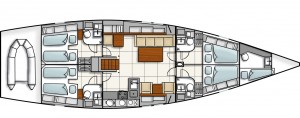
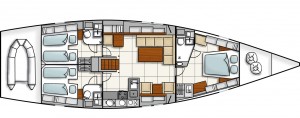
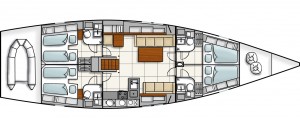
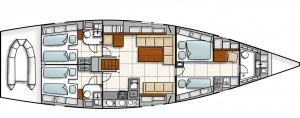
The key component in this formula is a high aspect-ratio 9/10 rig, with a self-tacking, furling headsail.
In the case of the Hanse 540 the jib clew has a crow’s foot arrangement to spread sheet loads through the sail and position the foot of the sail as close as possible to the car. The jib sheet is spliced to the car, runs through a clew block, back to the car block and up to a sheave in the mast, just below the first spreader. The sheet runs over the mast sheave, down inside the stick to a deck turning block and aft to a powered sheet/halyard winch. This may seem a rather convoluted way of sheeting a self-tacker, but the geometry works. By taking the sheet up the mast the angle into the sheave is narrow, regardless of the car position on the track, so sheet friction and sheave loading are limited. The uncluttered deck extends right to the bow, where a flush-hatch opens to reveal the chain locker; but not any ordinary chain locker. The Hanse 540e has its anchor mounted on a swinging davit that raises and lowers through 180° with gas strut assistance. When not required, the anchor and davit fold out of sight under the deck. There’s also no need to have the gennaker bag cluttering the deck, because it can be hoisted from and stowed into a huge sail locker that’s just aft of the chain locker.
Below, the Hanse 540 offers a distinct interior with a strong Euro flair. 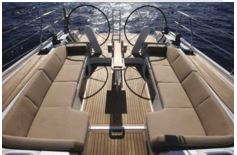 Bold fabrics, white bulkheads, dark Corian counters and sink, and mahogany woodwork play off each other to create a modern, perhaps stark, look. In the saloon, there is a decided lack of fiddles throughout, a reflection of the builder’s belief that most meals will be cooked in harbor, noted Jim Williams, a St. Petersburg Hanse dealer. There are four interior layouts available; the boat we sailed offered a spacious owner’s stateroom forward and two cabins with double berths aft. The Hanse 540’s companionway is quite steep and best handled in the classic seafaring tradition of backing down. The treads are grooved for grip and a pair of teak handholds makes the task quite safe. The saloon, galley and navigation station fit into a huge, open-plan area, with enough headroom to keep a basketball player bruise free. In fact, the cabin roof handholds are beyond the reach of shorties. The companionway lifted to provide front access to the engine, with additional side access panels in the aft cabins. The engine sat deep in the boat, allowing space for a genset on top. Engine and genset noise was well muffled above and below deck.
Bold fabrics, white bulkheads, dark Corian counters and sink, and mahogany woodwork play off each other to create a modern, perhaps stark, look. In the saloon, there is a decided lack of fiddles throughout, a reflection of the builder’s belief that most meals will be cooked in harbor, noted Jim Williams, a St. Petersburg Hanse dealer. There are four interior layouts available; the boat we sailed offered a spacious owner’s stateroom forward and two cabins with double berths aft. The Hanse 540’s companionway is quite steep and best handled in the classic seafaring tradition of backing down. The treads are grooved for grip and a pair of teak handholds makes the task quite safe. The saloon, galley and navigation station fit into a huge, open-plan area, with enough headroom to keep a basketball player bruise free. In fact, the cabin roof handholds are beyond the reach of shorties. The companionway lifted to provide front access to the engine, with additional side access panels in the aft cabins. The engine sat deep in the boat, allowing space for a genset on top. Engine and genset noise was well muffled above and below deck.
The Hanse 540 has a sleek and racy appearance: Genoa tracks are recessed into the deck and all six mooring cleats are collapsible. Both anchor and bow roller fold back and are tucked away in the covered chain locker. Just aft is a roomy storage area that’s enclosed by a watertight bulkhead between it and the owner’s cabin.
Sources: “Cruising World” & “Boat Point“.
Condividi post su:
We suggest other ships that could be of your interest
-
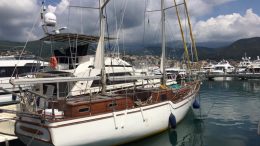
ALBATROS 49
-

BARBERIS 511
-
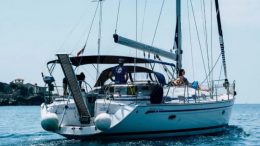
BAVARIA 50
-
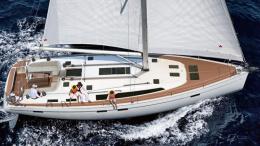
BAVARIA 51
-
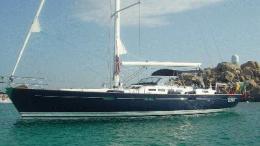
BENETEAU 57
-
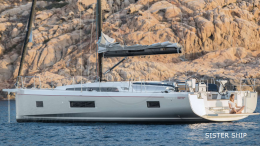
OCEANIS 51.1
-
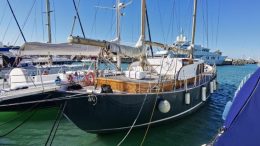
CAMPER & NICHOLSON 18 MT
-
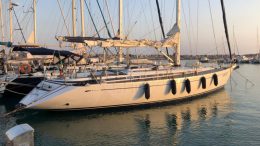
GRAND SOLEIL 50
-

COMET 52RS
-

VALLICELLI 18

FLY

HARD TOP

OPEN

RUBBER DINGHY

CLASSIC OLD

MULTIHULL CATAMARAN

CRUISING

CRUISING/RACER

RACER

CLASSIC OLD

MULTIHULL CATAMARAN
Scegli Prezzo (€)
Min
- 10.000
- 15.000
- 20.000
- 25.000
- 30.000
- 35.000
- 40.000
- 45.000
- 50.000
- 55.000
- 60.000
- 65.000
- 70.000
- 75.000
- 80.000
- 85.000
- 90.000
- 95.000
- 100.000
- 110.000
- 120.000
- 130.000
- 140.000
- 150.000
- 160.000
- 170.000
- 180.000
- 190.000
- 200.000
- 220.000
- 240.000
- 260.000
- 280.000
- 300.000
- 330.000
- 360.000
- 390.000
- 400.000
- 440.000
- 480.000
- 500.000
- 550.000
- 600.000
- 650.000
- 700.000
- 750.000
- 800.000
- 850.000
- 900.000
- 950.000
- 1.000.000
- TUTTO
Max
- 10.000
- 15.000
- 20.000
- 25.000
- 30.000
- 35.000
- 40.000
- 45.000
- 50.000
- 55.000
- 60.000
- 65.000
- 70.000
- 75.000
- 80.000
- 85.000
- 90.000
- 95.000
- 100.000
- 110.000
- 120.000
- 130.000
- 140.000
- 150.000
- 160.000
- 170.000
- 180.000
- 190.000
- 200.000
- 220.000
- 240.000
- 260.000
- 280.000
- 300.000
- 330.000
- 360.000
- 390.000
- 400.000
- 440.000
- 480.000
- 500.000
- 550.000
- 600.000
- 650.000
- 700.000
- 750.000
- 800.000
- 850.000
- 900.000
- 950.000
- 1.000.000
- TUTTO
Scegli Anno
Min
- 2025
- 2018
- 2015
- 2012
- 2009
- 2006
- 2003
- 2000
- 1997
- 1994
- 1991
- 1988
- 1985
- 1982
- 1979
- 1976
- 1973
- 1970
- 1967
- 1964
- 1961
- 1958
- 1955
- 1952
- 1949
- 1946
- 1943
- 1940
- 1937
- 1934
- 1931
- 1928
- 1925
- 1922
- 1919
- 1916
- 1913
- 1910
- 1907
- 1904
- 1901
- 1900
Max
- 2025
- 2018
- 2015
- 2012
- 2009
- 2006
- 2003
- 2000
- 1997
- 1994
- 1991
- 1988
- 1985
- 1982
- 1979
- 1976
- 1973
- 1970
- 1967
- 1964
- 1961
- 1958
- 1955
- 1952
- 1949
- 1946
- 1943
- 1940
- 1937
- 1934
- 1931
- 1928
- 1925
- 1922
- 1919
- 1916
- 1913
- 1910
- 1907
- 1904
- 1901
- 1900
Scegli Lunghezza (mt)
Min
- 6,00
- 6,50
- 7,00
- 7,50
- 8,00
- 8,50
- 9,00
- 9,50
- 10,00
- 10,50
- 11,00
- 11,50
- 12,00
- 12,50
- 13,00
- 13,50
- 14,00
- 14,50
- 15,00
- 15,50
- 16,00
- 16,50
- 17,00
- 17,50
- 18,00
- 18,50
- 19,00
- 19,50
- 20,00
- 20,50
- 21,00
- 21,50
- 22,00
- 22,50
- 23,00
- 23,50
- 24,00
- 24,50
- 25,00
- 25,50
- 26,00
- 26,50
- 27,00
- 27,50
- 28,00
- 28,50
- 29,00
- 29,50
- 30,00
- 30,50
- 31,00
- 31,50
- 32,00
- 32,50
- 33,00
- 33,50
- 34,00
- 34,50
- 35,00
- 35,50
- 36,00
- 36,50
- 37,00
- 37,50
- 38,00
- 38,50
- 39,00
- 39,50
- 40,00
- 40,50
- 41,00
- 41,50
- 42,00
- 42,50
- 43,00
- 43,50
- 44,00
- 44,50
- 45,00
- 45,50
- 46,00
- 46,50
- 47,00
- 47,50
- 48,00
- 48,50
- 49,00
- 49,50
- 50,00
- 50,50
- 51,00
- 51,50
- 52,00
- 52,50
- 53,00
- 53,50
- 54,00
- 54,50
- 55,00
- 55,50
- 56,00
- 56,50
- 57,00
- 57,50
- 58,00
- 58,50
- 59,00
- 59,50
- 60,00
- 60,50
- 61,00
- 61,50
- 62,00
- 62,50
- 63,00
- 63,50
- 64,00
- 64,50
- 65,00
- 65,50
- 66,00
- 66,50
- 67,00
- 67,50
- 68,00
- 68,50
- 69,00
- 69,50
- 70,00
- 70,50
- 71,00
- 71,50
- 72,00
- 72,50
- 73,00
- 73,50
- 74,00
- 74,50
- 75,00
- 75,50
- 76,00
- 76,50
- 77,00
- 77,50
- 78,00
- 78,50
- 79,00
- 79,50
- 80,00
- 80,50
- 81,00
- 81,50
- 82,00
- 82,50
- 83,00
- 83,50
- 84,00
- 84,50
- 85,00
- 85,50
- 86,00
- 86,50
- 87,00
- 87,50
- 88,00
- 88,50
- 89,00
- 89,50
- 90,00
- 90,50
- 91,00
- 91,50
- 92,00
- 92,50
- 93,00
- 93,50
- 94,00
- 94,50
- 95,00
- 95,50
- 96,00
- 96,50
- 97,00
- 97,50
- 98,00
- 98,50
- 99,00
- 99,50
- 100,00
- 100,50
- 101,00
- 101,50
- 102,00
- 102,50
- 103,00
- 103,50
- 104,00
- 104,50
- 105,00
- 105,50
- 106,00
- 106,50
- 107,00
- 107,50
- 108,00
- 108,50
- 109,00
- 109,50
- 110,00
- 110,50
- 111,00
- 111,50
- 112,00
- 112,50
- 113,00
- 113,50
- 114,00
- 114,50
- 115,00
- 115,50
- 116,00
- 116,50
- 117,00
- 117,50
- 118,00
- 118,50
- 119,00
- 119,50
- 120,00
- 120,50
- 121,00
- 121,50
- 122,00
- 122,50
- 123,00
- 123,50
- 124,00
- 124,50
- 125,00
- 125,50
- 126,00
- 126,50
- 127,00
- 127,50
- 128,00
- 128,50
- 129,00
- 129,50
- 130,00
- 130,50
- 131,00
- 131,50
- 132,00
- 132,50
- 133,00
- 133,50
- 134,00
- 134,50
- 135,00
- 135,50
- 136,00
- 136,50
- 137,00
- 137,50
- 138,00
- 138,50
- 139,00
- 139,50
- 140,00
- 140,50
- 141,00
- 141,50
- 142,00
- 142,50
- 143,00
- 143,50
- 144,00
- 144,50
- 145,00
- 145,50
- 146,00
- 146,50
- 147,00
- 147,50
- 148,00
- 148,50
- 149,00
- 149,50
- 150,00
- 150,50
- 151,00
- 151,50
- 152,00
- 152,50
- 153,00
- 153,50
- 154,00
- 154,50
- 155,00
- 155,50
- 156,00
- 156,50
- 157,00
- 157,50
- 158,00
- 158,50
- 159,00
- 159,50
- 160,00
- 160,50
- 161,00
- 161,50
- 162,00
- 162,50
- 163,00
- 163,50
- 164,00
- 164,50
- 165,00
- 165,50
- 166,00
- 166,50
- 167,00
- 167,50
- 168,00
- 168,50
- 169,00
- 169,50
- 170,00
- 170,50
- 171,00
- 171,50
- 172,00
- 172,50
- 173,00
- 173,50
- 174,00
- 174,50
- 175,00
- 175,50
- 176,00
- 176,50
- 177,00
- 177,50
- 178,00
- 178,50
- 179,00
- 179,50
Max
- 6,00
- 6,50
- 7,00
- 7,50
- 8,00
- 8,50
- 9,00
- 9,50
- 10,00
- 10,50
- 11,00
- 11,50
- 12,00
- 12,50
- 13,00
- 13,50
- 14,00
- 14,50
- 15,00
- 15,50
- 16,00
- 16,50
- 17,00
- 17,50
- 18,00
- 18,50
- 19,00
- 19,50
- 20,00
- 20,50
- 21,00
- 21,50
- 22,00
- 22,50
- 23,00
- 23,50
- 24,00
- 24,50
- 25,00
- 25,50
- 26,00
- 26,50
- 27,00
- 27,50
- 28,00
- 28,50
- 29,00
- 29,50
- 30,00
- 30,50
- 31,00
- 31,50
- 32,00
- 32,50
- 33,00
- 33,50
- 34,00
- 34,50
- 35,00
- 35,50
- 36,00
- 36,50
- 37,00
- 37,50
- 38,00
- 38,50
- 39,00
- 39,50
- 40,00
- 40,50
- 41,00
- 41,50
- 42,00
- 42,50
- 43,00
- 43,50
- 44,00
- 44,50
- 45,00
- 45,50
- 46,00
- 46,50
- 47,00
- 47,50
- 48,00
- 48,50
- 49,00
- 49,50
- 50,00
- 50,50
- 51,00
- 51,50
- 52,00
- 52,50
- 53,00
- 53,50
- 54,00
- 54,50
- 55,00
- 55,50
- 56,00
- 56,50
- 57,00
- 57,50
- 58,00
- 58,50
- 59,00
- 59,50
- 60,00
- 60,50
- 61,00
- 61,50
- 62,00
- 62,50
- 63,00
- 63,50
- 64,00
- 64,50
- 65,00
- 65,50
- 66,00
- 66,50
- 67,00
- 67,50
- 68,00
- 68,50
- 69,00
- 69,50
- 70,00
- 70,50
- 71,00
- 71,50
- 72,00
- 72,50
- 73,00
- 73,50
- 74,00
- 74,50
- 75,00
- 75,50
- 76,00
- 76,50
- 77,00
- 77,50
- 78,00
- 78,50
- 79,00
- 79,50
- 80,00
- 80,50
- 81,00
- 81,50
- 82,00
- 82,50
- 83,00
- 83,50
- 84,00
- 84,50
- 85,00
- 85,50
- 86,00
- 86,50
- 87,00
- 87,50
- 88,00
- 88,50
- 89,00
- 89,50
- 90,00
- 90,50
- 91,00
- 91,50
- 92,00
- 92,50
- 93,00
- 93,50
- 94,00
- 94,50
- 95,00
- 95,50
- 96,00
- 96,50
- 97,00
- 97,50
- 98,00
- 98,50
- 99,00
- 99,50
- 100,00
- 100,50
- 101,00
- 101,50
- 102,00
- 102,50
- 103,00
- 103,50
- 104,00
- 104,50
- 105,00
- 105,50
- 106,00
- 106,50
- 107,00
- 107,50
- 108,00
- 108,50
- 109,00
- 109,50
- 110,00
- 110,50
- 111,00
- 111,50
- 112,00
- 112,50
- 113,00
- 113,50
- 114,00
- 114,50
- 115,00
- 115,50
- 116,00
- 116,50
- 117,00
- 117,50
- 118,00
- 118,50
- 119,00
- 119,50
- 120,00
- 120,50
- 121,00
- 121,50
- 122,00
- 122,50
- 123,00
- 123,50
- 124,00
- 124,50
- 125,00
- 125,50
- 126,00
- 126,50
- 127,00
- 127,50
- 128,00
- 128,50
- 129,00
- 129,50
- 130,00
- 130,50
- 131,00
- 131,50
- 132,00
- 132,50
- 133,00
- 133,50
- 134,00
- 134,50
- 135,00
- 135,50
- 136,00
- 136,50
- 137,00
- 137,50
- 138,00
- 138,50
- 139,00
- 139,50
- 140,00
- 140,50
- 141,00
- 141,50
- 142,00
- 142,50
- 143,00
- 143,50
- 144,00
- 144,50
- 145,00
- 145,50
- 146,00
- 146,50
- 147,00
- 147,50
- 148,00
- 148,50
- 149,00
- 149,50
- 150,00
- 150,50
- 151,00
- 151,50
- 152,00
- 152,50
- 153,00
- 153,50
- 154,00
- 154,50
- 155,00
- 155,50
- 156,00
- 156,50
- 157,00
- 157,50
- 158,00
- 158,50
- 159,00
- 159,50
- 160,00
- 160,50
- 161,00
- 161,50
- 162,00
- 162,50
- 163,00
- 163,50
- 164,00
- 164,50
- 165,00
- 165,50
- 166,00
- 166,50
- 167,00
- 167,50
- 168,00
- 168,50
- 169,00
- 169,50
- 170,00
- 170,50
- 171,00
- 171,50
- 172,00
- 172,50
- 173,00
- 173,50
- 174,00
- 174,50
- 175,00
- 175,50
- 176,00
- 176,50
- 177,00
- 177,50
- 178,00
- 178,50
- 179,00
- 179,50
Scegli Larghezza (mt)
Min
- 2,00
- 2,10
- 2,20
- 2,30
- 2,40
- 2,50
- 2,60
- 2,70
- 2,80
- 2,90
- 3,00
- 3,10
- 3,20
- 3,30
- 3,40
- 3,50
- 3,60
- 3,70
- 3,80
- 3,90
- 4,00
- 4,10
- 4,20
- 4,30
- 4,40
- 4,50
- 4,60
- 4,70
- 4,80
- 4,90
- 5,00
- 5,10
- 5,20
- 5,30
- 5,40
- 5,50
- 5,60
- 5,70
- 5,80
- 5,90
- 6,00
- 6,10
- 6,20
- 6,30
- 6,40
- 6,50
- 6,60
- 6,70
- 6,80
- 6,90
- 7,00
- 7,10
- 7,20
- 7,30
- 7,40
- 7,50
- 7,60
- 7,70
- 7,80
- 7,90
- 8,00
- 8,10
- 8,20
- 8,30
- 8,40
- 8,50
- 8,60
- 8,70
- 8,80
- 8,90
- 9,00
- 9,10
- 9,20
- 9,30
- 9,40
- 9,50
- 9,60
- 9,70
- 9,80
- 9,90
- 10,00
- 10,10
- 10,20
- 10,30
- 10,40
- 10,50
- 10,60
- 10,70
- 10,80
- 10,90
- 11,00
- 11,10
- 11,20
- 11,30
- 11,40
- 11,50
- 11,60
- 11,70
- 11,80
- 11,90
- 12,00
- 12,10
- 12,20
- 12,30
- 12,40
- 12,50
- 12,60
- 12,70
- 12,80
- 12,90
- 13,00
- 13,10
- 13,20
- 13,30
- 13,40
- 13,50
- 13,60
- 13,70
- 13,80
- 13,90
- 14,00
- 14,10
- 14,20
- 14,30
- 14,40
- 14,50
- 14,60
- 14,70
- 14,80
- 14,90
- 15,00
Max
- 2,00
- 2,10
- 2,20
- 2,30
- 2,40
- 2,50
- 2,60
- 2,70
- 2,80
- 2,90
- 3,00
- 3,10
- 3,20
- 3,30
- 3,40
- 3,50
- 3,60
- 3,70
- 3,80
- 3,90
- 4,00
- 4,10
- 4,20
- 4,30
- 4,40
- 4,50
- 4,60
- 4,70
- 4,80
- 4,90
- 5,00
- 5,10
- 5,20
- 5,30
- 5,40
- 5,50
- 5,60
- 5,70
- 5,80
- 5,90
- 6,00
- 6,10
- 6,20
- 6,30
- 6,40
- 6,50
- 6,60
- 6,70
- 6,80
- 6,90
- 7,00
- 7,10
- 7,20
- 7,30
- 7,40
- 7,50
- 7,60
- 7,70
- 7,80
- 7,90
- 8,00
- 8,10
- 8,20
- 8,30
- 8,40
- 8,50
- 8,60
- 8,70
- 8,80
- 8,90
- 9,00
- 9,10
- 9,20
- 9,30
- 9,40
- 9,50
- 9,60
- 9,70
- 9,80
- 9,90
- 10,00
- 10,10
- 10,20
- 10,30
- 10,40
- 10,50
- 10,60
- 10,70
- 10,80
- 10,90
- 11,00
- 11,10
- 11,20
- 11,30
- 11,40
- 11,50
- 11,60
- 11,70
- 11,80
- 11,90
- 12,00
- 12,10
- 12,20
- 12,30
- 12,40
- 12,50
- 12,60
- 12,70
- 12,80
- 12,90
- 13,00
- 13,10
- 13,20
- 13,30
- 13,40
- 13,50
- 13,60
- 13,70
- 13,80
- 13,90
- 14,00
- 14,10
- 14,20
- 14,30
- 14,40
- 14,50
- 14,60
- 14,70
- 14,80
- 14,90
- 15,00
Scegli Immersione (mt)
Min
- 0,00
- 0,10
- 0,20
- 0,30
- 0,40
- 0,50
- 0,60
- 0,70
- 0,80
- 0,90
- 1,00
- 1,10
- 1,20
- 1,30
- 1,40
- 1,50
- 1,60
- 1,70
- 1,80
- 1,90
- 2,00
- 2,10
- 2,20
- 2,30
- 2,40
- 2,50
- 2,60
- 2,70
- 2,80
- 2,90
- 3,00
- 3,10
- 3,20
- 3,30
- 3,40
- 3,50
- 3,60
- 3,70
- 3,80
- 3,90
- 4,00
- 4,10
- 4,20
- 4,30
- 4,40
- 4,50
- 4,60
- 4,70
- 4,80
- 4,90
- 5,00
- 5,10
- 5,20
- 5,30
- 5,40
- 5,50
- 5,60
- 5,70
- 5,80
- 5,90
- 6,00
- 6,10
- 6,20
- 6,30
- 6,40
- 6,50
- 6,60
- 6,70
- 6,80
- 6,90
- 7,00
- 7,10
- 7,20
- 7,30
- 7,40
- 7,50
- 7,60
- 7,70
- 7,80
- 7,90
- 8,00
- 8,10
- 8,20
- 8,30
- 8,40
- 8,50
- 8,60
- 8,70
- 8,80
- 8,90
- 9,00
- 9,10
- 9,20
- 9,30
- 9,40
- 9,50
- 9,60
- 9,70
- 9,80
- 9,90
- 10,00
- 10,10
- 10,20
- 10,30
- 10,40
- 10,50
- 10,60
- 10,70
- 10,80
- 10,90
- 11,00
- 11,10
- 11,20
- 11,30
- 11,40
- 11,50
- 11,60
- 11,70
- 11,80
- 11,90
- 12,00
- 12,10
- 12,20
- 12,30
- 12,40
- 12,50
- 12,60
- 12,70
- 12,80
- 12,90
- 13,00
- 13,10
- 13,20
- 13,30
- 13,40
- 13,50
- 13,60
- 13,70
- 13,80
- 13,90
- 14,00
- 14,10
- 14,20
- 14,30
- 14,40
- 14,50
- 14,60
- 14,70
- 14,80
- 14,90
- 15,00
- 15,10
- 15,20
- 15,30
- 15,40
- 15,50
- 15,60
- 15,70
- 15,80
- 15,90
- 16,00
- 16,10
- 16,20
- 16,30
- 16,40
- 16,50
- 16,60
- 16,70
- 16,80
- 16,90
- 17,00
- 17,10
- 17,20
- 17,30
- 17,40
- 17,50
- 17,60
- 17,70
- 17,80
- 17,90
- 18,00
- 18,10
- 18,20
- 18,30
- 18,40
- 18,50
- 18,60
- 18,70
- 18,80
- 18,90
- 19,00
- 19,10
- 19,20
- 19,30
- 19,40
- 19,50
- 19,60
- 19,70
- 19,80
- 19,90
- 20,00
- 20,10
- 20,20
- 20,30
- 20,40
- 20,50
- 20,60
- 20,70
- 20,80
- 20,90
- 21,00
- 21,10
- 21,20
- 21,30
- 21,40
- 21,50
- 21,60
- 21,70
- 21,80
- 21,90
- 22,00
- 22,10
- 22,20
- 22,30
- 22,40
- 22,50
- 22,60
- 22,70
- 22,80
- 22,90
- 23,00
- 23,10
- 23,20
- 23,30
- 23,40
- 23,50
- 23,60
- 23,70
- 23,80
- 23,90
- 24,00
- 24,10
- 24,20
- 24,30
- 24,40
- 24,50
- 24,60
- 24,70
- 24,80
- 24,90
- 25,00
- 25,10
- 25,20
- 25,30
- 25,40
- 25,50
- 25,60
- 25,70
- 25,80
- 25,90
- 26,00
- 26,10
- 26,20
- 26,30
- 26,40
- 26,50
- 26,60
- 26,70
- 26,80
- 26,90
- 27,00
- 27,10
- 27,20
- 27,30
- 27,40
- 27,50
- 27,60
- 27,70
- 27,80
- 27,90
- 28,00
- 28,10
- 28,20
- 28,30
- 28,40
- 28,50
- 28,60
- 28,70
- 28,80
- 28,90
- 29,00
- 29,10
- 29,20
- 29,30
- 29,40
- 29,50
- 29,60
- 29,70
- 29,80
- 29,90
- 30,00
- 30,10
- 30,20
- 30,30
- 30,40
- 30,50
- 30,60
- 30,70
- 30,80
- 30,90
- 31,00
- 31,10
- 31,20
- 31,30
- 31,40
- 31,50
- 31,60
- 31,70
- 31,80
- 31,90
- 32,00
- 32,10
- 32,20
- 32,30
- 32,40
- 32,50
- 32,60
- 32,70
- 32,80
- 32,90
- 33,00
- 33,10
- 33,20
- 33,30
- 33,40
- 33,50
- 33,60
- 33,70
- 33,80
- 33,90
- 34,00
- 34,10
- 34,20
- 34,30
- 34,40
- 34,50
- 34,60
- 34,70
- 34,80
- 34,90
- 35,00
- 35,10
- 35,20
- 35,30
- 35,40
- 35,50
- 35,60
- 35,70
- 35,80
- 35,90
- 36,00
- 36,10
- 36,20
- 36,30
- 36,40
- 36,50
- 36,60
- 36,70
- 36,80
- 36,90
- 37,00
- 37,10
- 37,20
- 37,30
- 37,40
- 37,50
- 37,60
- 37,70
- 37,80
- 37,90
- 38,00
- 38,10
- 38,20
- 38,30
- 38,40
- 38,50
- 38,60
- 38,70
- 38,80
- 38,90
- 39,00
- 39,10
- 39,20
- 39,30
- 39,40
- 39,50
- 39,60
- 39,70
- 39,80
- 39,90
- 40,00
- 40,10
- 40,20
- 40,30
- 40,40
- 40,50
- 40,60
- 40,70
- 40,80
- 40,90
- 41,00
- 41,10
- 41,20
- 41,30
- 41,40
- 41,50
- 41,60
- 41,70
- 41,80
- 41,90
- 42,00
- 42,10
- 42,20
- 42,30
- 42,40
- 42,50
- 42,60
- 42,70
- 42,80
- 42,90
- 43,00
- 43,10
- 43,20
- 43,30
- 43,40
- 43,50
- 43,60
- 43,70
- 43,80
- 43,90
- 44,00
- 44,10
- 44,20
- 44,30
- 44,40
- 44,50
- 44,60
- 44,70
- 44,80
- 44,90
- 45,00
- 45,10
- 45,20
- 45,30
- 45,40
- 45,50
- 45,60
- 45,70
- 45,80
- 45,90
- 46,00
- 46,10
- 46,20
- 46,30
- 46,40
- 46,50
- 46,60
- 46,70
- 46,80
- 46,90
- 47,00
- 47,10
- 47,20
- 47,30
- 47,40
- 47,50
- 47,60
- 47,70
- 47,80
- 47,90
- 48,00
- 48,10
- 48,20
- 48,30
- 48,40
- 48,50
- 48,60
- 48,70
- 48,80
- 48,90
- 49,00
- 49,10
- 49,20
- 49,30
- 49,40
- 49,50
- 49,60
- 49,70
- 49,80
- 49,90
- 50,00
- 50,10
- 50,20
- 50,30
- 50,40
- 50,50
- 50,60
- 50,70
- 50,80
- 50,90
- 51,00
- 51,10
- 51,20
- 51,30
- 51,40
- 51,50
- 51,60
- 51,70
- 51,80
- 51,90
- 52,00
- 52,10
- 52,20
- 52,30
- 52,40
- 52,50
- 52,60
- 52,70
- 52,80
- 52,90
- 53,00
- 53,10
- 53,20
- 53,30
- 53,40
- 53,50
- 53,60
- 53,70
- 53,80
- 53,90
- 54,00
- 54,10
- 54,20
- 54,30
- 54,40
- 54,50
- 54,60
- 54,70
- 54,80
- 54,90
- 55,00
- 55,10
- 55,20
- 55,30
- 55,40
- 55,50
- 55,60
- 55,70
- 55,80
- 55,90
- 56,00
- 56,10
- 56,20
- 56,30
- 56,40
- 56,50
- 56,60
- 56,70
- 56,80
- 56,90
- 57,00
- 57,10
- 57,20
- 57,30
- 57,40
- 57,50
- 57,60
- 57,70
- 57,80
- 57,90
- 58,00
- 58,10
- 58,20
- 58,30
- 58,40
- 58,50
- 58,60
- 58,70
- 58,80
- 58,90
- 59,00
- 59,10
- 59,20
- 59,30
- 59,40
- 59,50
- 59,60
- 59,70
- 59,80
- 59,90
- 60,00
- 60,10
- 60,20
- 60,30
- 60,40
- 60,50
- 60,60
- 60,70
- 60,80
- 60,90
- 61,00
- 61,10
- 61,20
- 61,30
- 61,40
- 61,50
- 61,60
- 61,70
- 61,80
- 61,90
- 62,00
- 62,10
- 62,20
- 62,30
- 62,40
- 62,50
- 62,60
- 62,70
- 62,80
- 62,90
- 63,00
- 63,10
- 63,20
- 63,30
- 63,40
- 63,50
- 63,60
- 63,70
- 63,80
- 63,90
- 64,00
- 64,10
- 64,20
- 64,30
- 64,40
- 64,50
- 64,60
- 64,70
- 64,80
- 64,90
- 65,00
- 65,10
- 65,20
- 65,30
- 65,40
- 65,50
- 65,60
- 65,70
- 65,80
- 65,90
- 66,00
- 66,10
- 66,20
- 66,30
- 66,40
- 66,50
- 66,60
- 66,70
- 66,80
- 66,90
- 67,00
- 67,10
- 67,20
- 67,30
- 67,40
- 67,50
- 67,60
- 67,70
- 67,80
- 67,90
- 68,00
- 68,10
- 68,20
- 68,30
- 68,40
- 68,50
- 68,60
- 68,70
- 68,80
- 68,90
- 69,00
- 69,10
- 69,20
- 69,30
- 69,40
- 69,50
- 69,60
- 69,70
- 69,80
- 69,90
- 70,00
- 70,10
- 70,20
- 70,30
- 70,40
- 70,50
- 70,60
- 70,70
- 70,80
- 70,90
- 71,00
- 71,10
- 71,20
- 71,30
- 71,40
- 71,50
- 71,60
- 71,70
- 71,80
- 71,90
- 72,00
- 72,10
- 72,20
- 72,30
- 72,40
- 72,50
- 72,60
- 72,70
- 72,80
- 72,90
- 73,00
- 73,10
- 73,20
- 73,30
- 73,40
- 73,50
- 73,60
- 73,70
- 73,80
- 73,90
- 74,00
- 74,10
- 74,20
- 74,30
- 74,40
- 74,50
- 74,60
- 74,70
- 74,80
- 74,90
- 75,00
- 75,10
- 75,20
- 75,30
- 75,40
- 75,50
- 75,60
- 75,70
- 75,80
- 75,90
- 76,00
- 76,10
- 76,20
- 76,30
- 76,40
- 76,50
- 76,60
- 76,70
- 76,80
- 76,90
- 77,00
- 77,10
- 77,20
- 77,30
- 77,40
- 77,50
- 77,60
- 77,70
- 77,80
- 77,90
- 78,00
- 78,10
- 78,20
- 78,30
- 78,40
- 78,50
- 78,60
- 78,70
- 78,80
- 78,90
- 79,00
- 79,10
- 79,20
- 79,30
- 79,40
- 79,50
- 79,60
- 79,70
- 79,80
- 79,90
- 80,00
- 80,10
- 80,20
- 80,30
- 80,40
- 80,50
- 80,60
- 80,70
- 80,80
- 80,90
- 81,00
- 81,10
- 81,20
- 81,30
- 81,40
- 81,50
- 81,60
- 81,70
- 81,80
- 81,90
- 82,00
- 82,10
- 82,20
- 82,30
- 82,40
- 82,50
- 82,60
- 82,70
- 82,80
- 82,90
- 83,00
- 83,10
- 83,20
- 83,30
- 83,40
- 83,50
- 83,60
- 83,70
- 83,80
- 83,90
- 84,00
- 84,10
- 84,20
- 84,30
- 84,40
- 84,50
- 84,60
- 84,70
- 84,80
- 84,90
- 85,00
- 85,10
- 85,20
- 85,30
- 85,40
- 85,50
- 85,60
- 85,70
- 85,80
- 85,90
- 86,00
- 86,10
- 86,20
- 86,30
- 86,40
- 86,50
- 86,60
- 86,70
- 86,80
- 86,90
- 87,00
- 87,10
- 87,20
- 87,30
- 87,40
- 87,50
- 87,60
- 87,70
- 87,80
- 87,90
- 88,00
- 88,10
- 88,20
- 88,30
- 88,40
- 88,50
- 88,60
- 88,70
- 88,80
- 88,90
- 89,00
- 89,10
- 89,20
- 89,30
- 89,40
- 89,50
- 89,60
- 89,70
- 89,80
- 89,90
- 90,00
- 90,10
- 90,20
- 90,30
- 90,40
- 90,50
- 90,60
- 90,70
- 90,80
- 90,90
- 91,00
- 91,10
- 91,20
- 91,30
- 91,40
- 91,50
- 91,60
- 91,70
- 91,80
- 91,90
- 92,00
- 92,10
- 92,20
- 92,30
- 92,40
- 92,50
- 92,60
- 92,70
- 92,80
- 92,90
- 93,00
- 93,10
- 93,20
- 93,30
- 93,40
- 93,50
- 93,60
- 93,70
- 93,80
- 93,90
- 94,00
- 94,10
- 94,20
- 94,30
- 94,40
- 94,50
- 94,60
- 94,70
- 94,80
- 94,90
- 95,00
- 95,10
- 95,20
- 95,30
- 95,40
- 95,50
- 95,60
- 95,70
- 95,80
- 95,90
- 96,00
- 96,10
- 96,20
- 96,30
- 96,40
- 96,50
- 96,60
- 96,70
- 96,80
- 96,90
- 97,00
- 97,10
- 97,20
- 97,30
- 97,40
- 97,50
- 97,60
- 97,70
- 97,80
- 97,90
- 98,00
- 98,10
- 98,20
- 98,30
- 98,40
- 98,50
- 98,60
- 98,70
- 98,80
- 98,90
- 99,00
- 99,10
- 99,20
- 99,30
- 99,40
- 99,50
- 99,60
- 99,70
- 99,80
- 99,90
- 100,00
- 100,10
- 100,20
- 100,30
- 100,40
- 100,50
- 100,60
- 100,70
- 100,80
- 100,90
- 101,00
- 101,10
- 101,20
- 101,30
- 101,40
- 101,50
- 101,60
- 101,70
- 101,80
- 101,90
- 102,00
- 102,10
- 102,20
- 102,30
- 102,40
- 102,50
- 102,60
- 102,70
- 102,80
- 102,90
- 103,00
- 103,10
- 103,20
- 103,30
- 103,40
- 103,50
- 103,60
- 103,70
- 103,80
- 103,90
- 104,00
- 104,10
- 104,20
- 104,30
- 104,40
- 104,50
- 104,60
- 104,70
- 104,80
- 104,90
- 105,00
- 105,10
- 105,20
- 105,30
- 105,40
- 105,50
- 105,60
- 105,70
- 105,80
- 105,90
- 106,00
- 106,10
- 106,20
- 106,30
- 106,40
- 106,50
- 106,60
- 106,70
- 106,80
- 106,90
- 107,00
- 107,10
- 107,20
- 107,30
- 107,40
- 107,50
- 107,60
- 107,70
- 107,80
- 107,90
- 108,00
- 108,10
- 108,20
- 108,30
- 108,40
- 108,50
- 108,60
- 108,70
- 108,80
- 108,90
- 109,00
- 109,10
- 109,20
- 109,30
- 109,40
- 109,50
- 109,60
- 109,70
- 109,80
- 109,90
- 110,00
- 110,10
- 110,20
- 110,30
- 110,40
- 110,50
- 110,60
- 110,70
- 110,80
- 110,90
- 111,00
- 111,10
- 111,20
- 111,30
- 111,40
- 111,50
- 111,60
- 111,70
- 111,80
- 111,90
- 112,00
- 112,10
- 112,20
- 112,30
- 112,40
- 112,50
- 112,60
- 112,70
- 112,80
- 112,90
- 113,00
- 113,10
- 113,20
- 113,30
- 113,40
- 113,50
- 113,60
- 113,70
- 113,80
- 113,90
- 114,00
- 114,10
- 114,20
- 114,30
- 114,40
- 114,50
- 114,60
- 114,70
- 114,80
- 114,90
- 115,00
- 115,10
- 115,20
- 115,30
- 115,40
- 115,50
- 115,60
- 115,70
- 115,80
- 115,90
- 116,00
- 116,10
- 116,20
- 116,30
- 116,40
- 116,50
- 116,60
- 116,70
- 116,80
- 116,90
- 117,00
- 117,10
- 117,20
- 117,30
- 117,40
- 117,50
- 117,60
- 117,70
- 117,80
- 117,90
- 118,00
- 118,10
- 118,20
- 118,30
- 118,40
- 118,50
- 118,60
- 118,70
- 118,80
- 118,90
- 119,00
- 119,10
- 119,20
- 119,30
- 119,40
- 119,50
- 119,60
- 119,70
- 119,80
- 119,90
- 120,00
- 120,10
- 120,20
- 120,30
- 120,40
- 120,50
- 120,60
- 120,70
- 120,80
- 120,90
- 121,00
- 121,10
- 121,20
- 121,30
- 121,40
- 121,50
- 121,60
- 121,70
- 121,80
- 121,90
- 122,00
- 122,10
- 122,20
- 122,30
- 122,40
- 122,50
- 122,60
- 122,70
- 122,80
- 122,90
- 123,00
- 123,10
- 123,20
- 123,30
- 123,40
- 123,50
- 123,60
- 123,70
- 123,80
- 123,90
- 124,00
- 124,10
- 124,20
- 124,30
- 124,40
- 124,50
- 124,60
- 124,70
- 124,80
- 124,90
- 125,00
- 125,10
- 125,20
- 125,30
- 125,40
- 125,50
- 125,60
- 125,70
- 125,80
- 125,90
- 126,00
- 126,10
- 126,20
- 126,30
- 126,40
- 126,50
- 126,60
- 126,70
- 126,80
- 126,90
- 127,00
- 127,10
- 127,20
- 127,30
- 127,40
- 127,50
- 127,60
- 127,70
- 127,80
- 127,90
- 128,00
- 128,10
- 128,20
- 128,30
- 128,40
- 128,50
- 128,60
- 128,70
- 128,80
- 128,90
- 129,00
- 129,10
- 129,20
- 129,30
- 129,40
- 129,50
- 129,60
- 129,70
- 129,80
- 129,90
- 130,00
- 130,10
- 130,20
- 130,30
- 130,40
- 130,50
- 130,60
- 130,70
- 130,80
- 130,90
- 131,00
- 131,10
- 131,20
- 131,30
- 131,40
- 131,50
- 131,60
- 131,70
- 131,80
- 131,90
- 132,00
- 132,10
- 132,20
- 132,30
- 132,40
- 132,50
- 132,60
- 132,70
- 132,80
- 132,90
- 133,00
- 133,10
- 133,20
- 133,30
- 133,40
- 133,50
- 133,60
- 133,70
- 133,80
- 133,90
- 134,00
- 134,10
- 134,20
- 134,30
- 134,40
- 134,50
- 134,60
- 134,70
- 134,80
- 134,90
- 135,00
- 135,10
- 135,20
- 135,30
- 135,40
- 135,50
- 135,60
- 135,70
- 135,80
- 135,90
- 136,00
- 136,10
- 136,20
- 136,30
- 136,40
- 136,50
- 136,60
- 136,70
- 136,80
- 136,90
- 137,00
- 137,10
- 137,20
- 137,30
- 137,40
- 137,50
- 137,60
- 137,70
- 137,80
- 137,90
- 138,00
- 138,10
- 138,20
- 138,30
- 138,40
- 138,50
- 138,60
- 138,70
- 138,80
- 138,90
- 139,00
- 139,10
- 139,20
- 139,30
- 139,40
- 139,50
- 139,60
- 139,70
- 139,80
- 139,90
- 140,00
- 140,10
- 140,20
- 140,30
- 140,40
- 140,50
- 140,60
- 140,70
- 140,80
- 140,90
- 141,00
- 141,10
- 141,20
- 141,30
- 141,40
- 141,50
- 141,60
- 141,70
- 141,80
- 141,90
- 142,00
- 142,10
- 142,20
- 142,30
- 142,40
- 142,50
- 142,60
- 142,70
- 142,80
- 142,90
- 143,00
- 143,10
- 143,20
- 143,30
- 143,40
- 143,50
- 143,60
- 143,70
- 143,80
- 143,90
- 144,00
- 144,10
- 144,20
- 144,30
- 144,40
- 144,50
- 144,60
- 144,70
- 144,80
- 144,90
- 145,00
- 145,10
- 145,20
- 145,30
- 145,40
- 145,50
- 145,60
- 145,70
- 145,80
- 145,90
- 146,00
- 146,10
- 146,20
- 146,30
- 146,40
- 146,50
- 146,60
- 146,70
- 146,80
- 146,90
- 147,00
- 147,10
- 147,20
- 147,30
- 147,40
- 147,50
- 147,60
- 147,70
- 147,80
- 147,90
- 148,00
- 148,10
- 148,20
- 148,30
- 148,40
- 148,50
- 148,60
- 148,70
- 148,80
- 148,90
- 149,00
- 149,10
- 149,20
- 149,30
- 149,40
- 149,50
- 149,60
- 149,70
- 149,80
- 149,90
- 150,00
- 150,10
- 150,20
- 150,30
- 150,40
- 150,50
- 150,60
- 150,70
- 150,80
- 150,90
- 151,00
- 151,10
- 151,20
- 151,30
- 151,40
- 151,50
- 151,60
- 151,70
- 151,80
- 151,90
- 152,00
- 152,10
- 152,20
- 152,30
- 152,40
- 152,50
- 152,60
- 152,70
- 152,80
- 152,90
- 153,00
- 153,10
- 153,20
- 153,30
- 153,40
- 153,50
- 153,60
- 153,70
- 153,80
- 153,90
- 154,00
- 154,10
- 154,20
- 154,30
- 154,40
- 154,50
- 154,60
- 154,70
- 154,80
- 154,90
- 155,00
- 155,10
- 155,20
- 155,30
- 155,40
- 155,50
- 155,60
- 155,70
- 155,80
- 155,90
- 156,00
- 156,10
- 156,20
- 156,30
- 156,40
- 156,50
- 156,60
- 156,70
- 156,80
- 156,90
- 157,00
- 157,10
- 157,20
- 157,30
- 157,40
- 157,50
- 157,60
- 157,70
- 157,80
- 157,90
- 158,00
- 158,10
- 158,20
- 158,30
- 158,40
- 158,50
- 158,60
- 158,70
- 158,80
- 158,90
- 159,00
- 159,10
- 159,20
- 159,30
- 159,40
- 159,50
- 159,60
- 159,70
- 159,80
- 159,90
- 160,00
- 160,10
- 160,20
- 160,30
- 160,40
- 160,50
- 160,60
- 160,70
- 160,80
- 160,90
- 161,00
- 161,10
- 161,20
- 161,30
- 161,40
- 161,50
- 161,60
- 161,70
- 161,80
- 161,90
- 162,00
- 162,10
- 162,20
- 162,30
- 162,40
- 162,50
- 162,60
- 162,70
- 162,80
- 162,90
- 163,00
- 163,10
- 163,20
- 163,30
- 163,40
- 163,50
- 163,60
- 163,70
- 163,80
- 163,90
- 164,00
- 164,10
- 164,20
- 164,30
- 164,40
- 164,50
- 164,60
- 164,70
- 164,80
- 164,90
- 165,00
- 165,10
- 165,20
- 165,30
- 165,40
- 165,50
- 165,60
- 165,70
- 165,80
- 165,90
- 166,00
- 166,10
- 166,20
- 166,30
- 166,40
- 166,50
- 166,60
- 166,70
- 166,80
- 166,90
- 167,00
- 167,10
- 167,20
- 167,30
- 167,40
- 167,50
- 167,60
- 167,70
- 167,80
- 167,90
- 168,00
- 168,10
- 168,20
- 168,30
- 168,40
- 168,50
- 168,60
- 168,70
- 168,80
- 168,90
- 169,00
- 169,10
- 169,20
- 169,30
- 169,40
- 169,50
- 169,60
- 169,70
- 169,80
- 169,90
- 170,00
- 170,10
- 170,20
- 170,30
- 170,40
- 170,50
- 170,60
- 170,70
- 170,80
- 170,90
- 171,00
- 171,10
- 171,20
- 171,30
- 171,40
- 171,50
- 171,60
- 171,70
- 171,80
- 171,90
- 172,00
- 172,10
- 172,20
- 172,30
- 172,40
- 172,50
- 172,60
- 172,70
- 172,80
- 172,90
- 173,00
- 173,10
- 173,20
- 173,30
- 173,40
- 173,50
- 173,60
- 173,70
- 173,80
- 173,90
- 174,00
- 174,10
- 174,20
- 174,30
- 174,40
- 174,50
- 174,60
- 174,70
- 174,80
- 174,90
- 175,00
- 175,10
- 175,20
- 175,30
- 175,40
- 175,50
- 175,60
- 175,70
- 175,80
- 175,90
- 176,00
- 176,10
- 176,20
- 176,30
- 176,40
- 176,50
- 176,60
- 176,70
- 176,80
- 176,90
- 177,00
- 177,10
- 177,20
- 177,30
- 177,40
- 177,50
- 177,60
- 177,70
- 177,80
- 177,90
- 178,00
- 178,10
- 178,20
- 178,30
- 178,40
- 178,50
- 178,60
- 178,70
- 178,80
- 178,90
- 179,00
- 179,10
- 179,20
- 179,30
- 179,40
- 179,50
- 179,60
- 179,70
- 179,80
- 179,90
- 180,00
Max
- 0,00
- 0,10
- 0,20
- 0,30
- 0,40
- 0,50
- 0,60
- 0,70
- 0,80
- 0,90
- 1,00
- 1,10
- 1,20
- 1,30
- 1,40
- 1,50
- 1,60
- 1,70
- 1,80
- 1,90
- 2,00
- 2,10
- 2,20
- 2,30
- 2,40
- 2,50
- 2,60
- 2,70
- 2,80
- 2,90
- 3,00
- 3,10
- 3,20
- 3,30
- 3,40
- 3,50
- 3,60
- 3,70
- 3,80
- 3,90
- 4,00
- 4,10
- 4,20
- 4,30
- 4,40
- 4,50
- 4,60
- 4,70
- 4,80
- 4,90
- 5,00
- 5,10
- 5,20
- 5,30
- 5,40
- 5,50
- 5,60
- 5,70
- 5,80
- 5,90
- 6,00
- 6,10
- 6,20
- 6,30
- 6,40
- 6,50
- 6,60
- 6,70
- 6,80
- 6,90
- 7,00
- 7,10
- 7,20
- 7,30
- 7,40
- 7,50
- 7,60
- 7,70
- 7,80
- 7,90
- 8,00
- 8,10
- 8,20
- 8,30
- 8,40
- 8,50
- 8,60
- 8,70
- 8,80
- 8,90
- 9,00
- 9,10
- 9,20
- 9,30
- 9,40
- 9,50
- 9,60
- 9,70
- 9,80
- 9,90
- 10,00
- 10,10
- 10,20
- 10,30
- 10,40
- 10,50
- 10,60
- 10,70
- 10,80
- 10,90
- 11,00
- 11,10
- 11,20
- 11,30
- 11,40
- 11,50
- 11,60
- 11,70
- 11,80
- 11,90
- 12,00
- 12,10
- 12,20
- 12,30
- 12,40
- 12,50
- 12,60
- 12,70
- 12,80
- 12,90
- 13,00
- 13,10
- 13,20
- 13,30
- 13,40
- 13,50
- 13,60
- 13,70
- 13,80
- 13,90
- 14,00
- 14,10
- 14,20
- 14,30
- 14,40
- 14,50
- 14,60
- 14,70
- 14,80
- 14,90
- 15,00
- 15,10
- 15,20
- 15,30
- 15,40
- 15,50
- 15,60
- 15,70
- 15,80
- 15,90
- 16,00
- 16,10
- 16,20
- 16,30
- 16,40
- 16,50
- 16,60
- 16,70
- 16,80
- 16,90
- 17,00
- 17,10
- 17,20
- 17,30
- 17,40
- 17,50
- 17,60
- 17,70
- 17,80
- 17,90
- 18,00
- 18,10
- 18,20
- 18,30
- 18,40
- 18,50
- 18,60
- 18,70
- 18,80
- 18,90
- 19,00
- 19,10
- 19,20
- 19,30
- 19,40
- 19,50
- 19,60
- 19,70
- 19,80
- 19,90
- 20,00
- 20,10
- 20,20
- 20,30
- 20,40
- 20,50
- 20,60
- 20,70
- 20,80
- 20,90
- 21,00
- 21,10
- 21,20
- 21,30
- 21,40
- 21,50
- 21,60
- 21,70
- 21,80
- 21,90
- 22,00
- 22,10
- 22,20
- 22,30
- 22,40
- 22,50
- 22,60
- 22,70
- 22,80
- 22,90
- 23,00
- 23,10
- 23,20
- 23,30
- 23,40
- 23,50
- 23,60
- 23,70
- 23,80
- 23,90
- 24,00
- 24,10
- 24,20
- 24,30
- 24,40
- 24,50
- 24,60
- 24,70
- 24,80
- 24,90
- 25,00
- 25,10
- 25,20
- 25,30
- 25,40
- 25,50
- 25,60
- 25,70
- 25,80
- 25,90
- 26,00
- 26,10
- 26,20
- 26,30
- 26,40
- 26,50
- 26,60
- 26,70
- 26,80
- 26,90
- 27,00
- 27,10
- 27,20
- 27,30
- 27,40
- 27,50
- 27,60
- 27,70
- 27,80
- 27,90
- 28,00
- 28,10
- 28,20
- 28,30
- 28,40
- 28,50
- 28,60
- 28,70
- 28,80
- 28,90
- 29,00
- 29,10
- 29,20
- 29,30
- 29,40
- 29,50
- 29,60
- 29,70
- 29,80
- 29,90
- 30,00
- 30,10
- 30,20
- 30,30
- 30,40
- 30,50
- 30,60
- 30,70
- 30,80
- 30,90
- 31,00
- 31,10
- 31,20
- 31,30
- 31,40
- 31,50
- 31,60
- 31,70
- 31,80
- 31,90
- 32,00
- 32,10
- 32,20
- 32,30
- 32,40
- 32,50
- 32,60
- 32,70
- 32,80
- 32,90
- 33,00
- 33,10
- 33,20
- 33,30
- 33,40
- 33,50
- 33,60
- 33,70
- 33,80
- 33,90
- 34,00
- 34,10
- 34,20
- 34,30
- 34,40
- 34,50
- 34,60
- 34,70
- 34,80
- 34,90
- 35,00
- 35,10
- 35,20
- 35,30
- 35,40
- 35,50
- 35,60
- 35,70
- 35,80
- 35,90
- 36,00
- 36,10
- 36,20
- 36,30
- 36,40
- 36,50
- 36,60
- 36,70
- 36,80
- 36,90
- 37,00
- 37,10
- 37,20
- 37,30
- 37,40
- 37,50
- 37,60
- 37,70
- 37,80
- 37,90
- 38,00
- 38,10
- 38,20
- 38,30
- 38,40
- 38,50
- 38,60
- 38,70
- 38,80
- 38,90
- 39,00
- 39,10
- 39,20
- 39,30
- 39,40
- 39,50
- 39,60
- 39,70
- 39,80
- 39,90
- 40,00
- 40,10
- 40,20
- 40,30
- 40,40
- 40,50
- 40,60
- 40,70
- 40,80
- 40,90
- 41,00
- 41,10
- 41,20
- 41,30
- 41,40
- 41,50
- 41,60
- 41,70
- 41,80
- 41,90
- 42,00
- 42,10
- 42,20
- 42,30
- 42,40
- 42,50
- 42,60
- 42,70
- 42,80
- 42,90
- 43,00
- 43,10
- 43,20
- 43,30
- 43,40
- 43,50
- 43,60
- 43,70
- 43,80
- 43,90
- 44,00
- 44,10
- 44,20
- 44,30
- 44,40
- 44,50
- 44,60
- 44,70
- 44,80
- 44,90
- 45,00
- 45,10
- 45,20
- 45,30
- 45,40
- 45,50
- 45,60
- 45,70
- 45,80
- 45,90
- 46,00
- 46,10
- 46,20
- 46,30
- 46,40
- 46,50
- 46,60
- 46,70
- 46,80
- 46,90
- 47,00
- 47,10
- 47,20
- 47,30
- 47,40
- 47,50
- 47,60
- 47,70
- 47,80
- 47,90
- 48,00
- 48,10
- 48,20
- 48,30
- 48,40
- 48,50
- 48,60
- 48,70
- 48,80
- 48,90
- 49,00
- 49,10
- 49,20
- 49,30
- 49,40
- 49,50
- 49,60
- 49,70
- 49,80
- 49,90
- 50,00
- 50,10
- 50,20
- 50,30
- 50,40
- 50,50
- 50,60
- 50,70
- 50,80
- 50,90
- 51,00
- 51,10
- 51,20
- 51,30
- 51,40
- 51,50
- 51,60
- 51,70
- 51,80
- 51,90
- 52,00
- 52,10
- 52,20
- 52,30
- 52,40
- 52,50
- 52,60
- 52,70
- 52,80
- 52,90
- 53,00
- 53,10
- 53,20
- 53,30
- 53,40
- 53,50
- 53,60
- 53,70
- 53,80
- 53,90
- 54,00
- 54,10
- 54,20
- 54,30
- 54,40
- 54,50
- 54,60
- 54,70
- 54,80
- 54,90
- 55,00
- 55,10
- 55,20
- 55,30
- 55,40
- 55,50
- 55,60
- 55,70
- 55,80
- 55,90
- 56,00
- 56,10
- 56,20
- 56,30
- 56,40
- 56,50
- 56,60
- 56,70
- 56,80
- 56,90
- 57,00
- 57,10
- 57,20
- 57,30
- 57,40
- 57,50
- 57,60
- 57,70
- 57,80
- 57,90
- 58,00
- 58,10
- 58,20
- 58,30
- 58,40
- 58,50
- 58,60
- 58,70
- 58,80
- 58,90
- 59,00
- 59,10
- 59,20
- 59,30
- 59,40
- 59,50
- 59,60
- 59,70
- 59,80
- 59,90
- 60,00
- 60,10
- 60,20
- 60,30
- 60,40
- 60,50
- 60,60
- 60,70
- 60,80
- 60,90
- 61,00
- 61,10
- 61,20
- 61,30
- 61,40
- 61,50
- 61,60
- 61,70
- 61,80
- 61,90
- 62,00
- 62,10
- 62,20
- 62,30
- 62,40
- 62,50
- 62,60
- 62,70
- 62,80
- 62,90
- 63,00
- 63,10
- 63,20
- 63,30
- 63,40
- 63,50
- 63,60
- 63,70
- 63,80
- 63,90
- 64,00
- 64,10
- 64,20
- 64,30
- 64,40
- 64,50
- 64,60
- 64,70
- 64,80
- 64,90
- 65,00
- 65,10
- 65,20
- 65,30
- 65,40
- 65,50
- 65,60
- 65,70
- 65,80
- 65,90
- 66,00
- 66,10
- 66,20
- 66,30
- 66,40
- 66,50
- 66,60
- 66,70
- 66,80
- 66,90
- 67,00
- 67,10
- 67,20
- 67,30
- 67,40
- 67,50
- 67,60
- 67,70
- 67,80
- 67,90
- 68,00
- 68,10
- 68,20
- 68,30
- 68,40
- 68,50
- 68,60
- 68,70
- 68,80
- 68,90
- 69,00
- 69,10
- 69,20
- 69,30
- 69,40
- 69,50
- 69,60
- 69,70
- 69,80
- 69,90
- 70,00
- 70,10
- 70,20
- 70,30
- 70,40
- 70,50
- 70,60
- 70,70
- 70,80
- 70,90
- 71,00
- 71,10
- 71,20
- 71,30
- 71,40
- 71,50
- 71,60
- 71,70
- 71,80
- 71,90
- 72,00
- 72,10
- 72,20
- 72,30
- 72,40
- 72,50
- 72,60
- 72,70
- 72,80
- 72,90
- 73,00
- 73,10
- 73,20
- 73,30
- 73,40
- 73,50
- 73,60
- 73,70
- 73,80
- 73,90
- 74,00
- 74,10
- 74,20
- 74,30
- 74,40
- 74,50
- 74,60
- 74,70
- 74,80
- 74,90
- 75,00
- 75,10
- 75,20
- 75,30
- 75,40
- 75,50
- 75,60
- 75,70
- 75,80
- 75,90
- 76,00
- 76,10
- 76,20
- 76,30
- 76,40
- 76,50
- 76,60
- 76,70
- 76,80
- 76,90
- 77,00
- 77,10
- 77,20
- 77,30
- 77,40
- 77,50
- 77,60
- 77,70
- 77,80
- 77,90
- 78,00
- 78,10
- 78,20
- 78,30
- 78,40
- 78,50
- 78,60
- 78,70
- 78,80
- 78,90
- 79,00
- 79,10
- 79,20
- 79,30
- 79,40
- 79,50
- 79,60
- 79,70
- 79,80
- 79,90
- 80,00
- 80,10
- 80,20
- 80,30
- 80,40
- 80,50
- 80,60
- 80,70
- 80,80
- 80,90
- 81,00
- 81,10
- 81,20
- 81,30
- 81,40
- 81,50
- 81,60
- 81,70
- 81,80
- 81,90
- 82,00
- 82,10
- 82,20
- 82,30
- 82,40
- 82,50
- 82,60
- 82,70
- 82,80
- 82,90
- 83,00
- 83,10
- 83,20
- 83,30
- 83,40
- 83,50
- 83,60
- 83,70
- 83,80
- 83,90
- 84,00
- 84,10
- 84,20
- 84,30
- 84,40
- 84,50
- 84,60
- 84,70
- 84,80
- 84,90
- 85,00
- 85,10
- 85,20
- 85,30
- 85,40
- 85,50
- 85,60
- 85,70
- 85,80
- 85,90
- 86,00
- 86,10
- 86,20
- 86,30
- 86,40
- 86,50
- 86,60
- 86,70
- 86,80
- 86,90
- 87,00
- 87,10
- 87,20
- 87,30
- 87,40
- 87,50
- 87,60
- 87,70
- 87,80
- 87,90
- 88,00
- 88,10
- 88,20
- 88,30
- 88,40
- 88,50
- 88,60
- 88,70
- 88,80
- 88,90
- 89,00
- 89,10
- 89,20
- 89,30
- 89,40
- 89,50
- 89,60
- 89,70
- 89,80
- 89,90
- 90,00
- 90,10
- 90,20
- 90,30
- 90,40
- 90,50
- 90,60
- 90,70
- 90,80
- 90,90
- 91,00
- 91,10
- 91,20
- 91,30
- 91,40
- 91,50
- 91,60
- 91,70
- 91,80
- 91,90
- 92,00
- 92,10
- 92,20
- 92,30
- 92,40
- 92,50
- 92,60
- 92,70
- 92,80
- 92,90
- 93,00
- 93,10
- 93,20
- 93,30
- 93,40
- 93,50
- 93,60
- 93,70
- 93,80
- 93,90
- 94,00
- 94,10
- 94,20
- 94,30
- 94,40
- 94,50
- 94,60
- 94,70
- 94,80
- 94,90
- 95,00
- 95,10
- 95,20
- 95,30
- 95,40
- 95,50
- 95,60
- 95,70
- 95,80
- 95,90
- 96,00
- 96,10
- 96,20
- 96,30
- 96,40
- 96,50
- 96,60
- 96,70
- 96,80
- 96,90
- 97,00
- 97,10
- 97,20
- 97,30
- 97,40
- 97,50
- 97,60
- 97,70
- 97,80
- 97,90
- 98,00
- 98,10
- 98,20
- 98,30
- 98,40
- 98,50
- 98,60
- 98,70
- 98,80
- 98,90
- 99,00
- 99,10
- 99,20
- 99,30
- 99,40
- 99,50
- 99,60
- 99,70
- 99,80
- 99,90
- 100,00
- 100,10
- 100,20
- 100,30
- 100,40
- 100,50
- 100,60
- 100,70
- 100,80
- 100,90
- 101,00
- 101,10
- 101,20
- 101,30
- 101,40
- 101,50
- 101,60
- 101,70
- 101,80
- 101,90
- 102,00
- 102,10
- 102,20
- 102,30
- 102,40
- 102,50
- 102,60
- 102,70
- 102,80
- 102,90
- 103,00
- 103,10
- 103,20
- 103,30
- 103,40
- 103,50
- 103,60
- 103,70
- 103,80
- 103,90
- 104,00
- 104,10
- 104,20
- 104,30
- 104,40
- 104,50
- 104,60
- 104,70
- 104,80
- 104,90
- 105,00
- 105,10
- 105,20
- 105,30
- 105,40
- 105,50
- 105,60
- 105,70
- 105,80
- 105,90
- 106,00
- 106,10
- 106,20
- 106,30
- 106,40
- 106,50
- 106,60
- 106,70
- 106,80
- 106,90
- 107,00
- 107,10
- 107,20
- 107,30
- 107,40
- 107,50
- 107,60
- 107,70
- 107,80
- 107,90
- 108,00
- 108,10
- 108,20
- 108,30
- 108,40
- 108,50
- 108,60
- 108,70
- 108,80
- 108,90
- 109,00
- 109,10
- 109,20
- 109,30
- 109,40
- 109,50
- 109,60
- 109,70
- 109,80
- 109,90
- 110,00
- 110,10
- 110,20
- 110,30
- 110,40
- 110,50
- 110,60
- 110,70
- 110,80
- 110,90
- 111,00
- 111,10
- 111,20
- 111,30
- 111,40
- 111,50
- 111,60
- 111,70
- 111,80
- 111,90
- 112,00
- 112,10
- 112,20
- 112,30
- 112,40
- 112,50
- 112,60
- 112,70
- 112,80
- 112,90
- 113,00
- 113,10
- 113,20
- 113,30
- 113,40
- 113,50
- 113,60
- 113,70
- 113,80
- 113,90
- 114,00
- 114,10
- 114,20
- 114,30
- 114,40
- 114,50
- 114,60
- 114,70
- 114,80
- 114,90
- 115,00
- 115,10
- 115,20
- 115,30
- 115,40
- 115,50
- 115,60
- 115,70
- 115,80
- 115,90
- 116,00
- 116,10
- 116,20
- 116,30
- 116,40
- 116,50
- 116,60
- 116,70
- 116,80
- 116,90
- 117,00
- 117,10
- 117,20
- 117,30
- 117,40
- 117,50
- 117,60
- 117,70
- 117,80
- 117,90
- 118,00
- 118,10
- 118,20
- 118,30
- 118,40
- 118,50
- 118,60
- 118,70
- 118,80
- 118,90
- 119,00
- 119,10
- 119,20
- 119,30
- 119,40
- 119,50
- 119,60
- 119,70
- 119,80
- 119,90
- 120,00
- 120,10
- 120,20
- 120,30
- 120,40
- 120,50
- 120,60
- 120,70
- 120,80
- 120,90
- 121,00
- 121,10
- 121,20
- 121,30
- 121,40
- 121,50
- 121,60
- 121,70
- 121,80
- 121,90
- 122,00
- 122,10
- 122,20
- 122,30
- 122,40
- 122,50
- 122,60
- 122,70
- 122,80
- 122,90
- 123,00
- 123,10
- 123,20
- 123,30
- 123,40
- 123,50
- 123,60
- 123,70
- 123,80
- 123,90
- 124,00
- 124,10
- 124,20
- 124,30
- 124,40
- 124,50
- 124,60
- 124,70
- 124,80
- 124,90
- 125,00
- 125,10
- 125,20
- 125,30
- 125,40
- 125,50
- 125,60
- 125,70
- 125,80
- 125,90
- 126,00
- 126,10
- 126,20
- 126,30
- 126,40
- 126,50
- 126,60
- 126,70
- 126,80
- 126,90
- 127,00
- 127,10
- 127,20
- 127,30
- 127,40
- 127,50
- 127,60
- 127,70
- 127,80
- 127,90
- 128,00
- 128,10
- 128,20
- 128,30
- 128,40
- 128,50
- 128,60
- 128,70
- 128,80
- 128,90
- 129,00
- 129,10
- 129,20
- 129,30
- 129,40
- 129,50
- 129,60
- 129,70
- 129,80
- 129,90
- 130,00
- 130,10
- 130,20
- 130,30
- 130,40
- 130,50
- 130,60
- 130,70
- 130,80
- 130,90
- 131,00
- 131,10
- 131,20
- 131,30
- 131,40
- 131,50
- 131,60
- 131,70
- 131,80
- 131,90
- 132,00
- 132,10
- 132,20
- 132,30
- 132,40
- 132,50
- 132,60
- 132,70
- 132,80
- 132,90
- 133,00
- 133,10
- 133,20
- 133,30
- 133,40
- 133,50
- 133,60
- 133,70
- 133,80
- 133,90
- 134,00
- 134,10
- 134,20
- 134,30
- 134,40
- 134,50
- 134,60
- 134,70
- 134,80
- 134,90
- 135,00
- 135,10
- 135,20
- 135,30
- 135,40
- 135,50
- 135,60
- 135,70
- 135,80
- 135,90
- 136,00
- 136,10
- 136,20
- 136,30
- 136,40
- 136,50
- 136,60
- 136,70
- 136,80
- 136,90
- 137,00
- 137,10
- 137,20
- 137,30
- 137,40
- 137,50
- 137,60
- 137,70
- 137,80
- 137,90
- 138,00
- 138,10
- 138,20
- 138,30
- 138,40
- 138,50
- 138,60
- 138,70
- 138,80
- 138,90
- 139,00
- 139,10
- 139,20
- 139,30
- 139,40
- 139,50
- 139,60
- 139,70
- 139,80
- 139,90
- 140,00
- 140,10
- 140,20
- 140,30
- 140,40
- 140,50
- 140,60
- 140,70
- 140,80
- 140,90
- 141,00
- 141,10
- 141,20
- 141,30
- 141,40
- 141,50
- 141,60
- 141,70
- 141,80
- 141,90
- 142,00
- 142,10
- 142,20
- 142,30
- 142,40
- 142,50
- 142,60
- 142,70
- 142,80
- 142,90
- 143,00
- 143,10
- 143,20
- 143,30
- 143,40
- 143,50
- 143,60
- 143,70
- 143,80
- 143,90
- 144,00
- 144,10
- 144,20
- 144,30
- 144,40
- 144,50
- 144,60
- 144,70
- 144,80
- 144,90
- 145,00
- 145,10
- 145,20
- 145,30
- 145,40
- 145,50
- 145,60
- 145,70
- 145,80
- 145,90
- 146,00
- 146,10
- 146,20
- 146,30
- 146,40
- 146,50
- 146,60
- 146,70
- 146,80
- 146,90
- 147,00
- 147,10
- 147,20
- 147,30
- 147,40
- 147,50
- 147,60
- 147,70
- 147,80
- 147,90
- 148,00
- 148,10
- 148,20
- 148,30
- 148,40
- 148,50
- 148,60
- 148,70
- 148,80
- 148,90
- 149,00
- 149,10
- 149,20
- 149,30
- 149,40
- 149,50
- 149,60
- 149,70
- 149,80
- 149,90
- 150,00
- 150,10
- 150,20
- 150,30
- 150,40
- 150,50
- 150,60
- 150,70
- 150,80
- 150,90
- 151,00
- 151,10
- 151,20
- 151,30
- 151,40
- 151,50
- 151,60
- 151,70
- 151,80
- 151,90
- 152,00
- 152,10
- 152,20
- 152,30
- 152,40
- 152,50
- 152,60
- 152,70
- 152,80
- 152,90
- 153,00
- 153,10
- 153,20
- 153,30
- 153,40
- 153,50
- 153,60
- 153,70
- 153,80
- 153,90
- 154,00
- 154,10
- 154,20
- 154,30
- 154,40
- 154,50
- 154,60
- 154,70
- 154,80
- 154,90
- 155,00
- 155,10
- 155,20
- 155,30
- 155,40
- 155,50
- 155,60
- 155,70
- 155,80
- 155,90
- 156,00
- 156,10
- 156,20
- 156,30
- 156,40
- 156,50
- 156,60
- 156,70
- 156,80
- 156,90
- 157,00
- 157,10
- 157,20
- 157,30
- 157,40
- 157,50
- 157,60
- 157,70
- 157,80
- 157,90
- 158,00
- 158,10
- 158,20
- 158,30
- 158,40
- 158,50
- 158,60
- 158,70
- 158,80
- 158,90
- 159,00
- 159,10
- 159,20
- 159,30
- 159,40
- 159,50
- 159,60
- 159,70
- 159,80
- 159,90
- 160,00
- 160,10
- 160,20
- 160,30
- 160,40
- 160,50
- 160,60
- 160,70
- 160,80
- 160,90
- 161,00
- 161,10
- 161,20
- 161,30
- 161,40
- 161,50
- 161,60
- 161,70
- 161,80
- 161,90
- 162,00
- 162,10
- 162,20
- 162,30
- 162,40
- 162,50
- 162,60
- 162,70
- 162,80
- 162,90
- 163,00
- 163,10
- 163,20
- 163,30
- 163,40
- 163,50
- 163,60
- 163,70
- 163,80
- 163,90
- 164,00
- 164,10
- 164,20
- 164,30
- 164,40
- 164,50
- 164,60
- 164,70
- 164,80
- 164,90
- 165,00
- 165,10
- 165,20
- 165,30
- 165,40
- 165,50
- 165,60
- 165,70
- 165,80
- 165,90
- 166,00
- 166,10
- 166,20
- 166,30
- 166,40
- 166,50
- 166,60
- 166,70
- 166,80
- 166,90
- 167,00
- 167,10
- 167,20
- 167,30
- 167,40
- 167,50
- 167,60
- 167,70
- 167,80
- 167,90
- 168,00
- 168,10
- 168,20
- 168,30
- 168,40
- 168,50
- 168,60
- 168,70
- 168,80
- 168,90
- 169,00
- 169,10
- 169,20
- 169,30
- 169,40
- 169,50
- 169,60
- 169,70
- 169,80
- 169,90
- 170,00
- 170,10
- 170,20
- 170,30
- 170,40
- 170,50
- 170,60
- 170,70
- 170,80
- 170,90
- 171,00
- 171,10
- 171,20
- 171,30
- 171,40
- 171,50
- 171,60
- 171,70
- 171,80
- 171,90
- 172,00
- 172,10
- 172,20
- 172,30
- 172,40
- 172,50
- 172,60
- 172,70
- 172,80
- 172,90
- 173,00
- 173,10
- 173,20
- 173,30
- 173,40
- 173,50
- 173,60
- 173,70
- 173,80
- 173,90
- 174,00
- 174,10
- 174,20
- 174,30
- 174,40
- 174,50
- 174,60
- 174,70
- 174,80
- 174,90
- 175,00
- 175,10
- 175,20
- 175,30
- 175,40
- 175,50
- 175,60
- 175,70
- 175,80
- 175,90
- 176,00
- 176,10
- 176,20
- 176,30
- 176,40
- 176,50
- 176,60
- 176,70
- 176,80
- 176,90
- 177,00
- 177,10
- 177,20
- 177,30
- 177,40
- 177,50
- 177,60
- 177,70
- 177,80
- 177,90
- 178,00
- 178,10
- 178,20
- 178,30
- 178,40
- 178,50
- 178,60
- 178,70
- 178,80
- 178,90
- 179,00
- 179,10
- 179,20
- 179,30
- 179,40
- 179,50
- 179,60
- 179,70
- 179,80
- 179,90
- 180,00
Scegli Nr cabine
Min
- 0
- 1
- 2
- 3
- 4
- 5
- 6
- 7
- 8
- 9
- 10
- 11
- 12
- 13
- 14
- 15
- 16
- 17
- 18
- 19
- 20
Max
- 0
- 1
- 2
- 3
- 4
- 5
- 6
- 7
- 8
- 9
- 10
- 11
- 12
- 13
- 14
- 15
- 16
- 17
- 18
- 19
- 20
Scegli Nr bagni
Min
- 0
- 1
- 2
- 3
- 4
- 5
- 6
- 7
- 8
- 9
- 10
- 11
- 12
- 13
- 14
- 15
- 16
- 17
- 18
- 19
- 20
Max
- 0
- 1
- 2
- 3
- 4
- 5
- 6
- 7
- 8
- 9
- 10
- 11
- 12
- 13
- 14
- 15
- 16
- 17
- 18
- 19
- 20
 English
English Italiano
Italiano  Français
Français  Español
Español  Deutsch
Deutsch 
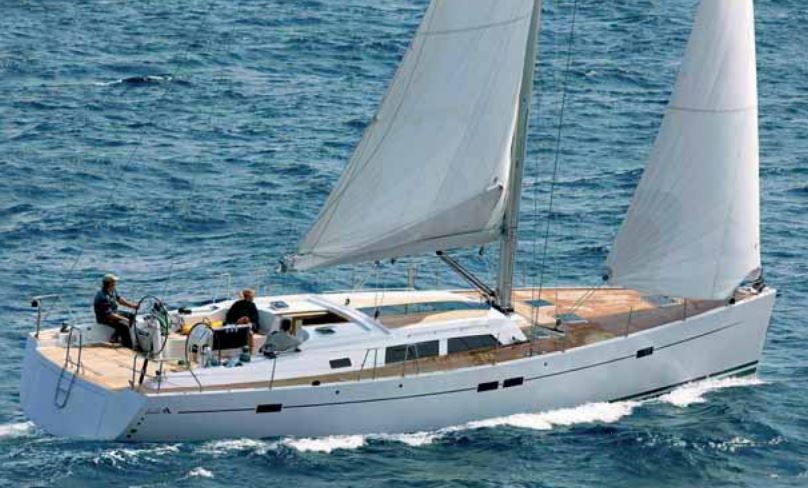
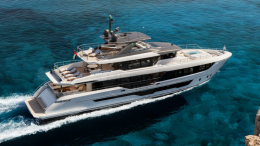
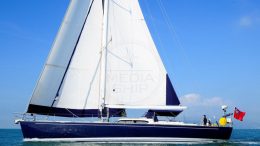
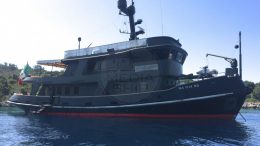
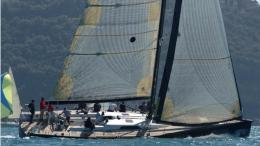
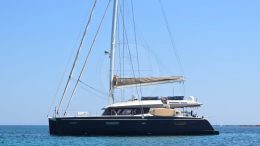
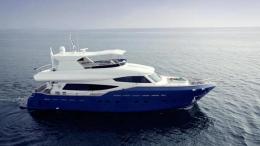
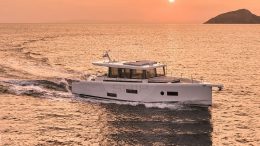
Follow us on: